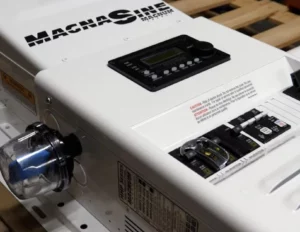Are you experiencing issues with your Magnum inverter? Don’t worry, we’ve got you covered! In this comprehensive guide, we will walk you through the troubleshooting process to help you identify and fix common problems with your Magnum inverter.
By following these step-by-step instructions, you’ll be able to maximize the performance of your inverter and ensure a smooth and efficient power supply. So let’s dive in and learn more about Magnum inverter troubleshooting!

Understanding the Basics of Magnum Inverters: An Introduction
Before we begin troubleshooting, it’s important to have a basic understanding of Magnum inverters. Magnum Energy is a leading manufacturer of high-quality inverters, chargers, and accessories for renewable energy systems.
Their inverters are designed to convert DC power from batteries into AC power for use in residential, commercial, and industrial applications. Magnum inverters are known for their reliability, durability, and advanced features.
Magnum inverters come in various models and sizes, catering to different power requirements. Whether you have a small off-grid system or a large grid-tied setup, the troubleshooting steps outlined in this guide will apply to most Magnum inverters. So let’s get started!
Identifying and Resolving Power Output Problems: A Step-by-Step Approach
One of the most common issues with inverters is a lack of power output. If you’re not getting the expected AC power output from your Magnum inverter, here’s a step-by-step approach to help you identify and resolve the problem:
- Check the battery voltage: Insufficient battery voltage can lead to low or no power output. Use a multimeter to measure the voltage of your battery bank and ensure it meets the manufacturer’s recommendations.
- Inspect the DC wiring: Loose or damaged DC wiring can cause power loss. Check all connections between the battery bank, inverter, and charge controller. Tighten any loose connections and replace any damaged cables.
- Examine the AC wiring: Faulty AC wiring can also affect power output. Inspect the connections between the inverter and your electrical panel or loads. Make sure all connections are secure and there are no loose or damaged wires.
- Monitor the inverter’s status lights: Magnum inverters are equipped with status lights that indicate the operating status and any potential issues. Refer to the user manual to understand the meaning of different status light patterns and troubleshoot accordingly.
- Reset the inverter: Sometimes, a simple reset can resolve power output problems. Consult the user manual to locate the reset button or procedure for your specific Magnum inverter model.
- Contact technical support: If you’ve followed all the above steps and still can’t resolve the power output issue, it’s time to reach out to Magnum Energy’s technical support. They have a team of experts who can provide further guidance and assistance.
Dealing with Battery Connection Issues: Ensuring a Strong and Stable Connection
A weak or unstable connection between your Magnum inverter and the battery bank can lead to various performance issues. To ensure a strong and stable battery connection, follow these steps:
- Clean the battery terminals: Over time, corrosion and dirt can build up on the battery terminals, affecting conductivity. Use a wire brush or battery terminal cleaner to remove any corrosion or dirt from the terminals.
- Tighten the battery terminals: Loose battery terminals can cause power loss and voltage fluctuations. Use a wrench or pliers to tighten the battery terminals securely.
- Inspect the battery cables: Check the battery cables for any signs of damage or wear. Replace any cables that are frayed, cracked, or corroded.
- Apply anti-corrosion spray: To prevent future corrosion, apply a thin layer of anti-corrosion spray or petroleum jelly to the battery terminals after cleaning and tightening them.
Overcoming Overheating Challenges: Strategies to Keep Your Inverter Cool
Overheating is a common problem in inverters, especially when they are operating under heavy loads or in high ambient temperatures. Here are some strategies to keep your Magnum inverter cool and prevent overheating:
- Ensure proper ventilation: Install your inverter in a well-ventilated area to allow for adequate airflow. Avoid placing the inverter in enclosed spaces or near heat sources.
- Clean the cooling fans: Dust and debris can accumulate on the cooling fans, hindering their performance. Regularly clean the fans using compressed air or a soft brush to remove any obstructions.
- Reduce the load: If your inverter is consistently overheating, consider reducing the load connected to it. Overloading the inverter can cause it to overheat and potentially damage internal components.
- Install additional cooling devices: In extreme cases, installing additional cooling devices such as external fans or heat sinks can help dissipate heat more effectively.
Addressing Fault Codes and Error Messages: Troubleshooting Tips and Solutions
Magnum inverters are equipped with a diagnostic system that displays fault codes and error messages to indicate specific issues. Here are some common fault codes and error messages you may encounter and their corresponding troubleshooting tips and solutions:
| Fault Code/Error Message | Troubleshooting Tips and Solutions |
|---|---|
| Fault code E01: Overvoltage | Check the input voltage from your power source and ensure it is within the inverter’s specified range. If the voltage exceeds the limit, consult an electrician to rectify the issue. |
| Error message E02: Low battery voltage | Verify the battery voltage and ensure it meets the inverter’s minimum requirement. If the voltage is low, recharge or replace the batteries as necessary. |
| Fault code E03: Overload | Reduce the load connected to the inverter or redistribute the load across multiple circuits to avoid overloading. Check the wiring and connections for any issues. |
| Error message E04: Overtemperature | Refer to the previous section on overcoming overheating challenges and implement the strategies mentioned. Ensure proper ventilation and cooling of the inverter. |
Maintaining and Caring for Your Magnum Inverter: Proactive Measures for Longevity and Reliability
To ensure the longevity and reliability of your Magnum inverter, regular maintenance and care are essential. Here are some proactive measures you can take:
- Keep the inverter clean: Regularly clean the exterior of the inverter using a soft cloth or brush. Avoid using abrasive cleaners or solvents that may damage the surface.
- Inspect for physical damage: Periodically check the inverter for any signs of physical damage such as cracks, dents, or loose components. If you notice any issues, contact technical support for further guidance.
- Monitor performance: Keep an eye on the inverter’s performance and look out for any unusual behavior or warning signs. This can help you identify potential problems early on and take appropriate action.
- Follow the manufacturer’s recommendations: Refer to the user manual for specific maintenance guidelines provided by Magnum Energy. Adhering to these recommendations will ensure optimal performance and prevent unnecessary damage.
Frequently Asked Questions about Magnum Inverter Troubleshooting Guide
Q: How do I reset my Magnum inverter?
A: To reset your Magnum inverter, locate the reset button or follow the reset procedure outlined in the user manual. Usually, you need to press and hold the reset button for a few seconds until the inverter restarts.
Q: Why is my inverter not turning on?
A: There could be several reasons why your inverter is not turning on, including a faulty power source, a blown fuse, or internal component failure. Check the input power, fuses, and connections to troubleshoot the issue.
Q: What should I do if my inverter keeps tripping the circuit breaker?
A: If your inverter keeps tripping the circuit breaker, it could indicate an overload or short circuit. Reduce the load connected to the inverter and check for any wiring or connection issues that may be causing the problem.
Q: Can I install my Magnum inverter myself, or do I need professional help?
A: While some experienced individuals may be able to install a Magnum inverter themselves, it is generally recommended to seek professional help. Proper installation is crucial to ensure safety, compliance with electrical codes, and optimal performance.
Expert Advice on Magnum Inverter Troubleshooting Guide
When it comes to troubleshooting your Magnum inverter, it’s always beneficial to seek expert advice. Here are a few tips from our experts:
- Read the user manual: Familiarize yourself with the inverter’s features, specifications, and troubleshooting guidelines provided in the user manual. It serves as a valuable resource for resolving common issues.
- Keep a log: Maintain a log of any problems, error codes, or unusual behavior you encounter with your inverter. This information can help technical support diagnose the issue more effectively.
- Stay updated: Check for firmware updates or software patches released by Magnum Energy. Keeping your inverter’s software up to date can address known bugs and improve overall performance.
- Don’t hesitate to ask for help: If you’re unsure about any aspect of troubleshooting or feel overwhelmed, don’t hesitate to reach out to technical support. They are there to assist you and ensure your inverter operates optimally.
By following the troubleshooting steps outlined in this guide and seeking expert advice when necessary, you can overcome common issues with your Magnum inverter and enjoy uninterrupted power supply.
Remember, regular maintenance and care are key to maximizing the longevity and reliability of your inverter. Happy troubleshooting!






